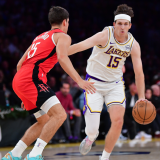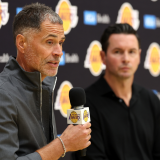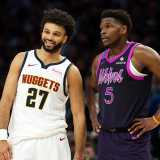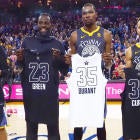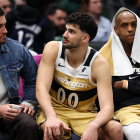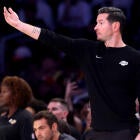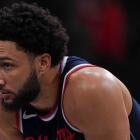Taking aim at the Warriors: Grading every attempt to close the gap in the superteam era
As we have seen in recent years, not all superteams are created equally
"In this fall, I'm going to take my talents to South Beach and join the Miami Heat."
On the evening of July 8, 2010, 25-year-old LeBron James spoke those words to Jim Gray in "The Decision" and ushered in what we think of as the era of the superteam. He would join his friends Dwyane Wade and Chris Bosh in Miami. Their superteam would make the next four NBA Finals and win two titles before LeBron decided to return to his hometown Cleveland Cavaliers where he, um, constructed another superteam, this one with perennial All-Stars Kyrie Irving and Kevin Love.
But LeBron's ambitions were quickly surpassed by the Golden State Warriors, a team that was originally built organically, built the "right way" -- by acquiring franchise cornerstones Stephen Curry, Klay Thompson and Draymond Green through the draft. Then, ya know, two years later, Kevin Durant turned heel and joined the Warriors, making them the superteam to beat all superteams.
And ever since the Warriors' first title, the rest of the NBA has been playing catch-up.
LeBron certainly didn't invent superteams, but he put the NBA's obsession with creating them and chasing them into overdrive. Before his Heat, there were the 2007-08 Boston Celtics, the 1996-97 Houston Rockets, the Philadelphia 76ers from the late 1970s and early 1980s, and plenty more. A brief definition of a proper superteam is that it's a team with at least two (and preferably three) superstars, each of whom could serve as a franchise cornerstone in their own right, and that these stars were brought together the "wrong way" -- not by drafting them but by free agency or trades well after these superstars were already recognized as such. Typically, these superteams create an existential crisis in the sports media as we wonder about the fairness of the superteam's tactics, and whether the existence of superteams is "ruining" the sport. But always, always, always, we watch these superteams for one reason or another -- out of bandwagon love or out of visceral hate or out of the joy of watching the very best players in the world try to gel as a cohesive team.
No superteam has been as dominant as the Golden State Warriors. This group might go down as the greatest dynasty of the modern NBA. But over the past four years, the rest of the NBA hasn't just thrown up its hands and prepared for the retirement of Steph and Klay a decade from now. (Er, perhaps a few teams have done that.) Here's a list of how the rest of the NBA's contenders and wannabe contenders have made major moves to try and catch up to the Warriors in the five years since this dynasty was birthed -- and grades for how these flurries of moves have worked out. -- Reid Forgrave
 Celtics make their first splash
Celtics make their first splash
When: July 2, 2016
What: Celtics sign unrestricted free agent Al Horford, one of the biggest free agents of the 2016 class, from the Atlanta Hawks on a four-year, $113 million contract.
The specifics: Al Horford became the first major free agent to sign with the Celtics, who'd won 48 games the season before. Some quibbled with the money, and it certainly was big money for a player never considered a traditional superstar -- someone who had never averaged more than 18.6 points per game -- but Horford's versatility, defense, team-first mentality and ability to do all the little things made him the perfect player for the foundation Brad Stevens was laying. More than that, Horford was a table-setter for what would become a completely revamped Celtics roster. (Today, only two players remain in Boston from the pre-Horford era: Marcus Smart and Terry Rozier.) Who knows where the Celtics would stand now if they didn't sign Horford. Sure, they'd still have the motherlode of assets they stole away from the Brooklyn Nets. But would Kyrie Irving have come to Boston? Would Gordon Hayward have? Would they be considered a prime landing spot for a player like Anthony Davis? Just one more savvy move from Danny Ainge. -- RF
Grade: A
 Cavs get reinforcements
Cavs get reinforcements
When: January-February 2017
What: The defending champion Cavs were "top-heavy as shit" in James' estimation, even after David Griffin's front office added Kyle Korver in exchange for a protected first-round pick (and, technically, Mike Dunleavy and Mo Williams). James demanded another playmaker, so Cleveland signed Deron Williams after he negotiated a buyout with Dallas.
The specifics: There were other midseason additions for the Cavaliers leading up to the 2017 playoffs -- Andrew Bogut, who immediately got injured; Larry Sanders; Derrick Williams; Dahntay Jones and Walter Tavares -- but Korver and Williams were the most consequential. Let's start with the positive: Korver fit in perfectly on offense, especially because Cleveland was desperate for shooting with J.R. Smith injured at the time, and he established chemistry with LeBron and Kevin Love right away. Despite having great difficulty getting open in their run to the NBA Finals, Korver re-signed on a three-year, $22 million deal that summer, and was at times Cleveland's second-best player during its insane trip back there last season, even at 37 years old. Williams had a fascinating but brief stint with the Cavaliers -- he basically couldn't miss in the regular season and the beginning of the playoffs, but was invisible for much of the conference finals and horrendous against the Warriors. He hasn't played professional basketball since. (Fun fact: While the post-LeBron Cavs mercifully traded Korver to the Jazz this past November, he still looms over the organization in the form of the pick they owe to the Hawks: It is top-10 protected for this season and next, then it turns into two second-round picks.) -- James Herbert
Grade: B+
 Boogie down in New Orleans
Boogie down in New Orleans
When: Feb. 19, 2017
What: New Orleans Pelicans get All-Star big man DeMarcus Cousins from the Sacramento Kings in a mega deal that sent rookie Buddy Hield, Tyreke Evans and Langston Galloway to Sacramento, as well as draft picks that would become Justin Jackson, Harry Giles and Frank Mason.
The specifics: In the middle of Anthony Davis' fifth season with the Pelicans, the team went all in. They had to, after having made the playoffs only once so far in Davis' tenure. So they sacrificed the team's depth in order to pair a second frontcourt superstar with The Brow. The Pelicans missed the playoffs anyway, going 11-14 with the Twin Towers the rest of the way. The next season, things looked somewhat promising. The Pelicans were in sixth place in the West when Cousins tore his Achilles tendon in January. While the Pelicans were able to make the playoffs without Cousins and win their first playoff series with Davis on the team, they didn't re-sign Cousins in the offseason. Fast forwarding to now, Davis has requested a trade from the Pelicans with a year and a half remaining on his contract, while the Kings have flourished as Hield has become one of the top 3-point shooters in the NBA, averaging more than 20 points per game. You can't blame the Pelicans for pulling the trigger on the deal, but it was always a moon shot, intended to make up for years of managerial ineptitude that could never surround Davis with commensurate talent. It's not fully fair to smear this trade, because who knows what could have become of this franchise if Boogie never tore that tendon -- but this trade helped set in motion the current crisis in New Orleans, where Davis is asking out. -- RF
Grade: C-
 Raptors get defensive
Raptors get defensive
When: February 2017
What: Looking to strengthen its defense and become more versatile after its first-ever trip to the conference finals, Toronto traded Terrence Ross and a first-round pick (which eventually became Anzejs Pasecniks) to Orlando for Serge Ibaka in advance of the trade deadline, and on deadline day it nabbed P.J. Tucker for almost nothing. (Phoenix received Jared Sullinger, who was immediately waived, plus two picks in the 50s that were used on Alec Peters and George King.)
The specifics: Masai Ujiri's front office was widely praised for the moves, especially because the Raptors were sort of sputtering before they were made. Toronto finished the regular season on a roll, going 18-7 after the deadline and winning 12 of its final 14 games, albeit with a favorable schedule. The playoffs were much more of a mixed bag: Ibaka was essential as the Raptors got past Milwaukee, and Tucker was their best defender against LeBron James in the second round, but they were swept by the Cavs, partially because Dwane Casey's coaching staff waited until Game 4 to start Tucker and play him major minutes. Ibaka re-signed on a three-year, $65 million contract in the summer and is now having a strong season after a rough 2017-18, but Tucker elected to go to Houston, where he has played a crucial role and came oh-so-close to making the NBA Finals last season. Toronto has its most talented roster ever these days, but it is still fair to wonder whether Ujiri would have offered Tucker more money if he could do it over again, even if it meant losing Ibaka. -- JH
Grade: C+
 76ers cash in a chip
76ers cash in a chip
When: June 18, 2017
What: 76ers swap the third overall pick (as well as a future first-rounder) with the Celtics for the No. 1 overall pick, which the 76ers would use to select Markelle Fultz.
The specifics: Whoops. The consensus immediately after this trade seemed to be that the 76ers had acquired the perfect young piece to put alongside young stars Joel Embiid and Ben Simmons. Here's just one representative critique from the day of the trade: "The Sixers get a potential All-Star at the point guard position … By acquiring Fultz, Simmons doesn't have to play the point guard position and learn on the job. And Fultz gives them a three-point threat to offset Simmons' lack of outside shooting." Oh, man. Fultz, as has been obsessively documented in the media, has been an utter disaster. While Fultz's story is far from finished -- we'll see if he can conquer his shooting demons, whether they be physical or mental -- the story of Jayson Tatum is only building. He's a future All-Star. Worse for the Sixers, Tatum looks like the ideal piece to slot in between Embiid and Simmons. A Sixers team that had drafted Tatum instead of Fultz would be considered the top Eastern Conference franchise for the foreseeable future. The Sixers team that drafted Fultz has gotten less than nothing for its troubles, and feels like a very good franchise that could top out just below the top tier in the East. This is where The Process lost its way. -- RF
Grade: D-
 Boston gets bold
Boston gets bold
When: 2017 offseason
What: In a flurry of big-time moves over the span of two months in the summer, Danny Ainge trades the No. 1 overall pick to Philadelphia for the No. 3 overall pick plus a future first-rounder, then signs free agent Gordon Hayward to a four-year, $128 million deal, then trades Isaiah Thomas, Jae Crowder, Ante Zizic and a 2018 first-round pick -- that would become Collin Sexton -- to Cleveland in exchange for Kyrie Irving.
The specifics: A few weeks after the Celtics completed a 53-win season that saw them get the 1-seed in the East and make the Eastern Conference finals, general manager Danny Ainge began to completely remake his roster. Ainge's 2017 offseason may be one of the prime examples of a team making major moves to keep up in the superteam era. Instead of being patient, he went for it. And even though the Celtics have underachieved so far this season -- they're currently in third place, five games behind the Milwaukee Bucks -- it's hard to argue that these moves were anything but a success. The devastating injury to Hayward in his first game as a Celtic could never have been predicted, and his return this season has been bumpy, to say the least. But the Tatum deal looks like an all-time act of thievery by Ainge, and Irving is putting together one of his finest seasons, and slowly maturing, in fits and starts, into a leader. Ainge had the flexibility to make this flurry of deals without constricting his future options; the Celtics have the best package of assets to secure a trade for Anthony Davis once they're able to make that trade this summer. A trade for Davis would be the ultimate coup for Ainge in this superteam era. Of course, that may not happen, and Irving could leave in free agency, and everything could very quickly go to pot in Boston. -- RF
Grade: A
 Cleveland's reconstruction
Cleveland's reconstruction
When: 2017 offseason
What: After failing to trade for Paul George and parting ways with their title-winning general manager, the Cavs signed Jose Calderon, Jeff Green and Derrick Rose to one-year, minimum contracts. Kyrie Irving made a franchise-altering trade request in August, and they sent him to Boston in exchange for Isaiah Thomas, Jae Crowder, Ante Zizic and the pick that became Collin Sexton. The trade was held up because of Thomas' health, but was eventually completed when the Celtics agreed to add a 2020 second-rounder. In late September, Dwyane Wade joined the (extremely strange) party, also on a one-year, minimum deal.
The specifics: The 20-year-old Sexton's development is the big remaining variable, but hot damn. As of now, the player who has produced the most for Cleveland out of this bunch is Jeff Green. In retrospect, it is hard to believe how effusively Koby Altman's front office was initially praised for the Irving trade. Thomas clearly should have had surgery on his hip, only playing 15 ineffective games for the Cavs before he and Crowder, never comfortable as strictly a spot-up shooter, were shipped off. Wade and Rose never made much sense on this team, Calderon was Calderon and Zizic is still hanging around, gobbling up rebounds. This group will be remembered for dreadful defense, terrible chemistry and inspiring James to pout until the front office essentially reset the roster. "Everyone knows that when Kyrie got traded it was the beginning of the end for everything," James told The Athletic's Joe Vardon this past November. "It's not a secret." The day it happened, James was on the phone with Altman, telling him not to do it, and he hung up believing that they'd agreed to hold off. -- JH
Grade: D-
 Rockets take aim
Rockets take aim
When: 2017 offseason
What: Houston made its big move before free agency began, trading Patrick Beverley, Lou Williams, Montrezl Harrell, Sam Dekker, Kyle Wiltjer and the first-round pick that became Omari Spellman to the Clippers for Chris Paul, who opted in for the final year of his contract to facilitate the swap. (The Rockets also had to trade cash for Darrun Hilliard and DeAndre Liggins' non-guaranteed contracts and send them to Los Angeles.) Daryl Morey's front office wasn't done, though, signing P.J. Tucker to a four-year, $31.3 million contract and scooping up Luc Richard Mbah a Moute on a one-year, minimum deal.
The specifics: James Harden was coming off an MVP-caliber season, his first as a "points guard" under coach Mike D'Antoni, but he famously struggled at the end of Houston's second-round series against the Spurs. Houston had two objectives in the summer: finding Harden some help and improving its defense, which ranked 18th in the league. Morey did that and then some, constructing a team that won 65 games in the loaded Western Conference. By switching more liberally than any team in NBA history and creating an environment that maximized Harden and Paul's playmaking, the Rockets caused real problems for the Warriors, and Morey was refreshingly honest about the fact that he was obsessed with beating them. They came as close as possible to doing just that, but Paul hurt his hamstring in the conference finals, and then an improbable 27 straight missed 3s doomed them in Game 7. (It is possible they wouldn't have been that close if Andre Iguodala hadn't missed the final four games, but that's neither here nor there.) -- JH
Grade: A+
 The Thunder's sorta-superteam
The Thunder's sorta-superteam
When: 2017 offseason (which leads directly to the 2018 offseason)
What: The Oklahoma City Thunder -- who had one of those rare, organic superteams several years ago after drafting Kevin Durant, Russell Westbrook and James Harden in short order -- made several moves in the 2017 offseason to surround Westbrook with a facsimile of a superteam. The Thunder traded Victor Oladipo and Domantas Sabonis to the Indiana Pacers for Paul George, and then traded Enes Kanter and Doug McDermott and a second-round pick (which became the promising Mitchell Robinson) to the New York Knicks for erstwhile superstar Carmelo Anthony. Meantime, they pinned their future to Westbrook as they signed him to a five-year supermax extension, and drafted Terrance Ferguson, a theoretical three-and-D wing.
The specifics: A yin-and-yang case here. While the Pacers' side of the Paul George deal was an unmitigated success, since they traded one year of George for two players who never quite fit with the Thunder (but would soon become an All-Star and a Sixth Man of the Year candidate in Indy), OKC would make that trade again in a heartbeat. It turned from a huge risk into a franchise-shaping coup. They upended the conventional wisdom that George was inevitably headed back to Southern California in free agency and re-signed George to a four-year, $137 million deal. In the first year of that extension, George has turned in his finest performance to date, supplanting Westbrook as this team's most effective player and garnering consideration as an MVP candidate. As for the other parts of that offseason: While Ferguson has been a decent rotation player, the Melo era in OKC was a failed experiment. The 10-time All-Star played the worst season of his career, averaging fewer points and shooting a lower percentage than ever before -- not to mention that awful, awful defense, if you want to call whatever it was "defense." He was summarily dismissed after one season in a trade for Dennis Schroder, who has been pretty good coming off the bench. -- RF
Grade: B
 Cleveland's re-reconstruction
Cleveland's re-reconstruction
When: Feb. 8, 2018
What: In an attempt to salvage the season, the Cavs made three trades on deadline day. To Los Angeles went Isaiah Thomas, Channing Frye and a first-round pick that became Moe Wagner; to Utah went Jae Crowder and the soon-to-be-waived Derrick Rose; to Sacramento went Iman Shumpert and a 2020 second-round pick; to Miami went Dwyane Wade. In return, the Cavs got Rodney Hood, George Hill, Larry Nance Jr. and Jordan Clarkson.
The specifics: With the Cavs flailing, this felt like a minor miracle. It also looked risky because it helped the Lakers clear cap space. I called it a "clear win" in terms of getting younger and more versatile, but cautioned that it couldn't properly be evaluated until James made his decision. With the benefit of hindsight, these moves look … OK, I guess? The Cavs were working on a one-year timeline because of James' impending free agency, and they weren't going anywhere with the group Altman's front office had patched together when they couldn't land George. On the strength of some superhuman performances from James, they wound up getting back to the Finals, where J.R. Smith forgot the score and the Warriors swept them. In the big picture, the additions have been underwhelming -- Hood signed the qualifying offer and on Sunday afternoon approved his trade to Portland, Clarkson's contract still has negative value and Hill was flipped to Milwaukee in December. Nance signed a four-year, $44.8 million extension in October, which isn't bad value, but he's the type of player who would look so much better on a winning team. With James in L.A., the Cavs are certainly not that. -- JH
Grade: C
 Spacing out in Milwaukee
Spacing out in Milwaukee
When: 2018 offseason
What: Milwaukee makes several connected moves to maximize the talents of franchise cornerstone Giannis Antetokounmpo.
The specifics: Despite keeping the same core, the Bucks radically shifted their philosophy in the offseason, turning an underachieving team that couldn't quite get over the hump into a team that's perhaps the class of the East. The first and most important was securing a new head coach in Mike Budenholzer, who constructed a 3-point-heavy offense (only the Rockets attempt more 3s than the Bucks) that maximized the strengths of superstar Giannis Antetokounmpo, and turned a defense that ranked 18th in the NBA a season ago into what's now the league's top-ranked defense. Other than LeBron James heading to the Lakers, there may have been no more important offseason acquisition than the coach the Bucks added. But they also brought in other impactful pieces who've been ideal fits in Budenholzer's scheme. They signed 3-point-gunning big man Brook Lopez, who is shooting 6.5 3-pointers a game at a near-40 percent clip -- signing him at the $3.4 million biannual exception might have been the biggest bargain of the offseason -- as well as 3-point-gunning big man Ersan Ilyasova, who is shooting 34.5 percent from downtown. They also signed Pat Connaughton and drafted Donte DiVincenzo, two high-energy guards who can add a spark off the bench. Just as importantly, they didn't re-sign former No. 2 pick Jabari Parker. While all these moved seemed to only be on the margins, together they added up to a completely new version of the Milwaukee Bucks. We'll see what sort of continuity the Bucks can have going into next season, as Lopez, Eric Bledsoe, Malcolm Brogdon and presumably Khris Middleton (who has a $13 million player option) will all become unrestricted free agents. -- RF
Grade: A
 LeBron goes Hollywood with strange supporting cast
LeBron goes Hollywood with strange supporting cast
When: July 2018
What: LeBron James signed a four-year, $153.3 million contract with the Lakers, who couldn't get a meeting with Paul George, couldn't trade for Kawhi Leonard and settled for signing one-year contracts with Kentavious Caldwell-Pope, Rajon Rondo, JaVale McGee, Lance Stephenson, and Michael Beasley, keeping their 2019 cap space open.
The specifics: James wanted to go to Los Angeles so badly that he was willing to sign a long-term deal despite the fact his co-stars were theoretical. When Magic Johnson and Rob Pelinka signed a bunch of veteran playmakers, eyebrows raised around the league, and it still seems silly that the Lakers didn't re-sign Brook Lopez or otherwise address their lack of 3-point shooting. Los Angeles has been better than expected defensively this season, but the offense has been a bit of an adventure, partially because of a never-ending stream of injuries. Unless the Lakers stun the world by getting Anthony Davis in the next few days before the Feb. 7 trade deadline, the popular perception will be that their young players' trade value has tumbled. How you evaluate this series of moves depends on how much you think this season really matters -- nobody thinks of this team as a genuine threat to Golden State as presently constructed, but Los Angeles is in a position to change that with a blockbuster trade and/or a signing. -- JH
Grade: A
 Toronto goes all-in
Toronto goes all-in
When: July 18, 2018
What: Toronto acquires disgruntled superstar Kawhi Leonard and wing Danny Green from the Spurs in exchange for the franchise's all-time leading scorer DeMar DeRozan, young center Jakob Poeltl and a 2019 first-round pick.
The specifics: After being swept by the Cavs again, the Raptors decided replacing coach Dwane Casey with Nick Nurse was not enough. They had no assurance Kawhi Leonard would be more than a one-year rental, but, in the spirit of their backup point guard, they bet on themselves: If they showed him they were a championship-caliber organization, would he really leave? The swap itself was perceived to be a bargain -- it is still sort of mind-blowing that they didn't need to give up on Pascal Siakam and O.G. Anunoby -- but it was somewhat controversial because of DeRozan's relationship with the city and the fact he was furious with the way it went down. From a basketball perspective, this has gone about as well as Toronto could have hoped. Leonard has played like an MVP candidate and the reinvigorated Green has had his most efficient season in years. The Raptors, however, were clear-eyed about how much this would raise the stakes. As you consider what they might do before Thursday's deadline, think about how desperately they need to get to the Finals. -- JH
Grade: A
 Houston doesn't bring the band back
Houston doesn't bring the band back
When: 2018 offseason through now
What: After a heartbreaking Game 7 loss against Golden State, the Rockets re-signed Chris Paul and Clint Capela … and watched Trevor Ariza and Luc Mbah a Moute sign one-year deals with the Suns and Clippers, respectively. But Houston has been busy: Carmelo Anthony and Michael Carter-Williams signed one-year deals in the offseason and have since been dismissed. Marquese Chriss and Brandon Knight were acquired from Phoenix for Ryan Anderson and De'Anthony Melton, but they are both out of the rotation and might soon be out the door. The Rockets also signed James Ennis to a two-year, $3.5 million deal and found undrafted rookie Gary Clark, who had his two-way contract converted to a three-year, $3.7 million deal. During the season, Houston has cycled through a bunch of players, most notably finding Austin Rivers and Kenneth Faried on the buyout market.
The specifics: Morey wants to be judged by what the roster looks like heading into the playoffs, so I'll play by his rules here. The unstoppable Harden has essentially made sure that Houston's offense is fine regardless of who is on the court with him, but the defense, currently ranked 27th, needs to be worlds better in order to avoid wasting the season. The Rockets' biggest problem is not the loss of Ariza, though, and it is obviously not the absence of Mbah a Moute, who was a non-factor in last year's postseason and has missed all but the Clippers' first four games due to a knee injury. It is that they have almost never been healthy. Let's see if Houston can trade a pick or two for a difference-maker at the deadline and/or find more buyout guys. Capela should be back right after the All-Star break, so the team will have about eight weeks before the playoffs to prove it can get back to the level it reached last season. (The Anthony experiment was pretty rough, though, wasn't it?) -- JH
Grade: C+ (for now)
 The 76ers go for it
The 76ers go for it
When: Nov. 10, 2019
What: The Sixers trade for Jimmy Butler (and don't forget Justin Patton!), sending Robert Covington, Dario Saric, Jerryd Bayless and a second-round pick to Minnesota in the deal.
The specifics: The Sixers made the deal they had to make after the Markelle Fultz selection quickly. They traded for a third superstar to go alongside Joel Embiid and Ben Simmons, making them the only team other than the Golden State Warriors to have three top-20 players on their roster (depending how you feel about Simmons) and theoretically vaulting them into the top tier in the East. Before the trade, the Sixers were good but not great -- 8-6, ranking an ugly 21st in offensive rating and ninth in defensive rating. Since the trade the Sixers have been very good but not quite great: 26-13 (the second-best record in the East during that span), ranking fifth in offense and 12th in defense. The trade really hurt their depth; since then, only five teams use their bench less than the 76ers, and only five teams have less bench scoring than the 76ers. Now the Sixers will have a decision to make in the offseason: Do you give a max contract to a player in Butler who turns 31 before next season, who already has a ton of miles on his body and who is injury-prone? You make that trade every time, don't get me wrong. And you give him that contract because, now, you have to. But The Process was a slow, deliberate, meticulously planned thing, and this trade sped it up into overdrive. -- RF
Grade: B+


